Work-Based Learning
Research References
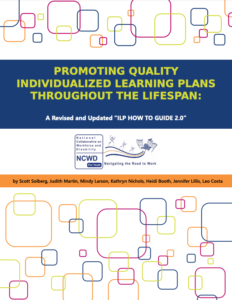 Promoting Quality Individualized Learning Plans throughout the Lifespan: A Revised and Updated ILP How to Guide 2.0 expands upon the guidance and resources in NCWD/Youth’s earlier ILP How to Guide. ILP How to Guide 2.0 provides career development resources and examples of ILP implementation for an expanded range of age groups and settings including elementary and secondary school, postsecondary education, workforce development programs and other non-school settings. It also offers strategies for building and supporting capacity at the local level to facilitate adoption of the ILP process and provides examples of how to ensure that ILPs are implemented with quality.
Promoting Quality Individualized Learning Plans throughout the Lifespan: A Revised and Updated ILP How to Guide 2.0 expands upon the guidance and resources in NCWD/Youth’s earlier ILP How to Guide. ILP How to Guide 2.0 provides career development resources and examples of ILP implementation for an expanded range of age groups and settings including elementary and secondary school, postsecondary education, workforce development programs and other non-school settings. It also offers strategies for building and supporting capacity at the local level to facilitate adoption of the ILP process and provides examples of how to ensure that ILPs are implemented with quality.
Solberg, S., Martin, J., Larson, M., Nichols, K., Booth, H., Lillis, J., & Costa, L. (2018, March 19). Promoting Quality Individualized Learning Plans throughout the Lifespan: A Revised and Updated ILP How to Guide 2.0.
Retrieved from
http://www.ncwd-youth.info/wp-content/uploads/2018/03/Promoting-Quality-ILPs-Throughout-the-Lifespan-WEB.pdf
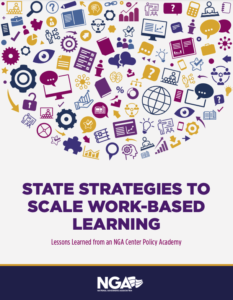 This report from the National Governors Association Center for Best Practices (NGA Center) aims to narrow the gap between what employers need and the type of skills employees entering the workforce possess, identifying core elements of system changes that can be used to embed work-based learning in K-12.
This report from the National Governors Association Center for Best Practices (NGA Center) aims to narrow the gap between what employers need and the type of skills employees entering the workforce possess, identifying core elements of system changes that can be used to embed work-based learning in K-12.
The report identifies and explores three key elements of systems change that should be pursued to scale high-quality, work-based learning and embed it across education and workforce programs: Setting, communicating, and implementing a statewide vision; Using data to measure and scale quality work-based learning opportunities; Cultivating resource development and policy change to support and scale work-based learning.
Stephens, R. (2020). State Strategies to Scale Work-Based Learning. Washington, DC: National Governors Association Center for Best Practices.
Retrieved from https://www.nga.org/wp-content/uploads/2020/02/NGA_Work-Based-Learning_Guide_final_web.pdf
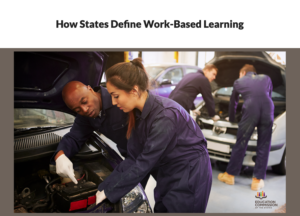 As policymakers, you may have a clear definition of each of the components that make up a quality work-based learning program, but is your definition and conceptualization consistent with other policymakers in your state who may have varying views and interests? Having a single definition helps to inform a common understanding among all stakeholders across a state, which can create more consistent experiences for students.
As policymakers, you may have a clear definition of each of the components that make up a quality work-based learning program, but is your definition and conceptualization consistent with other policymakers in your state who may have varying views and interests? Having a single definition helps to inform a common understanding among all stakeholders across a state, which can create more consistent experiences for students.
Twenty-eight states have a formal definition for work-based learning and many have components in common. This article explains some of the commonalities and differences in various state definitions.
Keily, T. (2019). How States Define Work-Based Learning. Denver, CO: Education Commission of the States.
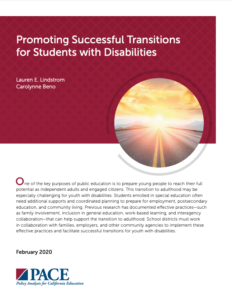 Transition to adulthood may be especially challenging for youth with disabilities. Students enrolled in special education often need additional supports and coordinated planning to prepare for employment, postsecondary education, and community living. This report details the implementation of effective practices–such as family involvement, inclusion in general education, work-based learning, and interagency collaboration–that can help support the transition to adulthood.
Transition to adulthood may be especially challenging for youth with disabilities. Students enrolled in special education often need additional supports and coordinated planning to prepare for employment, postsecondary education, and community living. This report details the implementation of effective practices–such as family involvement, inclusion in general education, work-based learning, and interagency collaboration–that can help support the transition to adulthood.
Lindstrom, L. E., & Beno, C. (2020). Promoting Successful Transitions for Students with Disabilities (Rep.). Stanford, CA: Policy Analysis for California Education.
Retrieved from https://files.eric.ed.gov/fulltext/ED605089.pdf
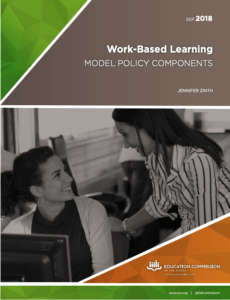 This Special Report outlines state-level policy components that help ensure work-based learning opportunities for high school students are well-coordinated, broadly accessible, aligned to state or regional workforce demands, and of high quality.
This Special Report outlines state-level policy components that help ensure work-based learning opportunities for high school students are well-coordinated, broadly accessible, aligned to state or regional workforce demands, and of high quality.
Zinth, J. (2018). Work-Based Learning: Model Policy Components. Denver, CO: Education Commission of the States.
Retrieved from https://www.ecs.org/wp-content/uploads/Work-Based-Learning-Model-Policy-Components.pdf
In today’s world, it is essential that undergraduate students gain career-relevant skills to be successful in the complex, global workforce. While employers raise concerns about students’ career-readiness, higher education institutions (HEIs) are facing numerous challenges, such as unprecedented access to a college education, funding allocations and students working while attending college. All these factors lead to an arduous situation. Since learning is not merely relegated to the classroom, this qualitative multisite case study focuses on experiential learning opportunities offered through university-affiliated business incubators to gain a better understanding of how they may assist undergraduate students prepare for the workforce.
Mayorga, L.K. (2019). HEIs and Workforce Development: Helping Undergraduates Acquire Career-Readiness Attributes. Industry and Higher Education, 33(6), 370-380.
Retrieved from https://journals.sagepub.com/doi/10.1177/0950422219875083
Additional Research References
- Raelin, J. A. (2008). Work-Based Learning: Bridging Knowledge and Action in the Workplace. John Wiley & Sons.
- Reeders, E. (2000). Scholarly Practice in Work-based Learning: Fitting the glass slipper. Higher Education Research & Development, 19(2), 205–220. https://doi.org/10.1080/072943600445655
- Cahill, C. (2016). Making Work-Based Learning Work. Boston, MA: Jobs for the Future. Retrieved from https://files.eric.ed.gov/fulltext/ED567846.pdf
- Advance CTE: State Leaders Connecting Learning to Work. (2016). Removing Legal Barriers around Work-Based Learning. Silver Spring, MD. Retrieved from https://files.eric.ed.gov/fulltext/ED580979.pdf
- Advance CTE: State Leaders Connecting Learning to Work. (2016). Measuring Work-Based Learning for Continuous Improvement. Silver Spring, MD. Retrieved from https://files.eric.ed.gov/fulltext/ED581093.pdf
- Advance CTE: State Leaders Connecting Learning to Work. (2016). Leveraging Intermediaries to Expand Work-Based Learning. Silver Spring, MD. Retrieved from https://files.eric.ed.gov/fulltext/ED581094.pdf
- Showalter, T, Spike, K. Promising Practices in Work-Based Learning for Youth. (2016). Retrieved from https://ns4ed.s3.us-east-2.amazonaws.com/wbl/4-10-4-nsc-youthworkbasedlearning_v42.pdf
- Tennessee Department of Education. Work-Based Learning (WBL) Framework. (2014). Retrieved from https://ns4ed.s3.us-east-2.amazonaws.com/wbl/6wbl_framework_intro.pdf
- Building a Work-Based Learning (WBL) System. PowerPoint retrieved from https://ns4ed.s3.us-east-2.amazonaws.com/wbl/3wbl_building_a_wbl_system.pdf
- Work-Based Learning Certification and Professional Development. (2015). Retrieved from https://ns4ed.s3.us-east-2.amazonaws.com/wbl/7wbl_certification_and_prof_dev.pdf
- Work-Based Learning Career Practicum. (2016). Retrieved from https://ns4ed.s3.us-east-2.amazonaws.com/wbl/10cte_std_career_practicum.pdf
- Career Exploration. (2016). Retrieved from https://ns4ed.s3.us-east-2.amazonaws.com/wbl/11cte_std_career_exploration.pdf
- Work-Based Learning Policy Guide. (2016). Retrieved from https://ns4ed.s3.us-east-2.amazonaws.com/wbl/12wbl_policy_guide-1.pdf
- Quick Reference: Service-Learning and Work-Based Learning Requirements. (2016). Retrieved from https://ns4ed.s3.us-east-2.amazonaws.com/wbl/13wbl_sl_reqs_quick_ref-1.pdf
- Work-Based Learning 101: A Resource for Industry.(2016). Retrieved from https://ns4ed.s3.us-east-2.amazonaws.com/wbl/1wbl_101_for_industry.pdf
- Work-Based Learning TN Child Labor Law Quick Reference Guide. (2016). Retrieved from https://ns4ed.s3.us-east-2.amazonaws.com/wbl/8wbl_child_labor_law_quick_reference.pdf
- Work-Based Learning Certification & Professional Development. Retrieved from https://ns4ed.s3.us-east-2.amazonaws.com/wbl/9wbl_certification_quickreferencedeck.pdf
- Work-Based Learning: Myths vs. Facts. Retrieved from https://ns4ed.s3.us-east-2.amazonaws.com/wbl/5wbl_myths_vs_facts_industry.pdf
- Work-Based Learning FAQ. (2016). Retrieved from https://ns4ed.s3.us-east-2.amazonaws.com/wbl/2wbl_faq.pdf